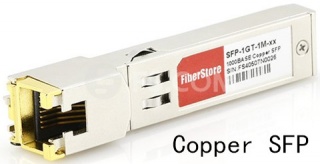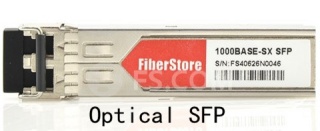Copper & Optical SFP Modules
srijeda , 25.05.2016.In order to maintain the configuration flexibility and establish connections that allow smooth data transfer from the source to the end point, SFP transceiver modules are utilized in the copper or optical Gigabit Ethernet (GbE) networks. SFP (Small Form-factor Pluggable) is a compact, hot-swappable, input/output device used in data communication and telecommunications networks. SFP interfaces between communication devices like switches, routers and fiber optic cables, performing optical and electrical signal conversion. There are many copper an optical SFP transceivers based on different GbE physical layers, such as Cisco 1000BASE-T SFP-GE-T and 1000BASE-SX SFP MGBSX1.
GbE Development
The initial standard for GbE was produced by the IEEE in June 1998 as IEEE 802.3z. Two designs were ratified in IEEE 802.3z to transmit signals over optical cables: the 1000BASE-SX uses short-wavelength laser (850nm) on multi-mode fiber (MMF), and the 1000BASE-LX uses long-wavelength laser (1310nm) on the standard single-mode fiber (SMF). At that time, transmitting 1000Mbps signals on the widely deployed Category 5 UTP was a significant challenge for silicon-chip designers. It requires tremendous signal processing to mitigate the channel impairments in copper wires such as ISI (intersymbol interference) introduced by limited channel bandwidth and signal crosstalks between pairs of copper wires. It was not until a year later that the 1000BASE-T standard (IEEE 802.3ab) was finished. To keep the cost of GbE low, the IEEE 802.3z committee very conservatively defined the transmission distance limit of 1000BASE-SX as 300m, and that of 1000BASE-LX as 5 km.
SFP Port Types
Specified by the Multisource Agreement (MSA), SFP, also known as a mini gigabit interface converter (GBIC), delivers the similar functions just as what a GBIC does, but designed with a much smaller size. As mentioned above, SFP transceiver has several interfaces which are standardized to work on SMFs and MMFs. Besides, SFP transceivers are also available with copper cable interfaces, like 1000BASE-T. This means that SFP module which is designed primarily for optical fiber communications can also communicate over unshielded twisted pair (UTP) cables. The image below shows different GbE SFP standards.
Copper SFP Modules
The development of copper technology in SFP modules is of great importance in enabling system designers to meet objectives while simplifying their inventory and reducing operating costs. These copper SFP transceivers scale Ethernet 10/100Mbps performance to 1000Mbps. Compared with 1Gbps, 1000BASE-T is 100 times as fast as the standard Ethernet. Additionally, the Full Duplex Repeaters (FDRs), when coupled with 1000BASE-T, offer an easy-to-manage, high-burst rate, and shared-media solution capable of supporting both end users and server farms. Popular copper SFP products, like Cisco SFP-GE-T, are used in Gigabit networks and they are fully compatible with 1000Base-T.
Optical SFP Modules
Both 1000BASE-SX and 1000BASE-LX are standardized for fiber optics. They share the 8B/10B 1000BASE-X PCS line coding. In addition to the transmission media, the only difference between 1000BASE-SX and 1000BASE-LX lies in the physical medium dependent (PMD) layer which defines the laser transmitter and photodetector. The interface between the physical medium attachment (PMA) and PMD layer is simply a serial interface. This made it easy to reuse all the designs between 1000BSAE-SX and 1000BASE-LX except the PMD transceiver.
Modern optical SFP modules support digital diagnostics monitoring (DDM) functions, also known as digital optical monitoring (DOM). This feature gives users the ability to monitor the real-time parameters of SFP, such as optical output power, optical input power, temperature, laser-bias current and transceiver supply voltage. The real-time diagnostic parameters can be monitored to alert the system when the transceiver’s specified operating limits are exceeded and compliance cannot be ensured. What’s more, the DDM function can be used to isolate the particular location of fault in fiber optic network system. Combining the DDM interface status flags, transceiver hard pins and diagnostic parametric monitor data the specific location and cause of a link failure can be pinpointed. Certainly, DDM function also has its role in failure prediction on fiber optic links, which is based on the transceiver parametric performance., including device faults and high error rate conditions.
SFP Module Applications
Apart from GbE, SFP modules can also support other communications standards, including synchronous optical networking (SONET)/synchronous digital hierarchy (SDH), and fiber channel. They allow the transport of fast Ethernet and GbE LAN packets over time-division-multiplexing-based WANs, as well as the transmission of E1/T1 streams over packet-switched networks.
SFP Purchasing Tips
When picking such a SFP module for your network, the first important factor to be considered is the price, especially for those small and medium-sized enterprises who have a tight budget. The other points go to the product compatibility, stability, and reliability. Otherwise, no matter how low the price is, it’s of no use.
Conclusion
Copper and optical SFP modules have proven themselves as the useful devices for the increased bandwidth requirements of users with each passing day. Fiberstore supplies a wide range of SFPs to support both copper and optical interfaces. They are fully compatible with such famous brands as Cisco, Juniper, D-Link (ie. DEM-311GT). Here just lists a few for your reference. For more information about SFP modules, you can visit Fiberstore directly.
Oznake: GbE, SFP, 1000BASE-T, SFP-GE-T, 1000BASE-SX, MGBSX1, DEM-311GT, 1000BASE-LX
komentiraj (0) * ispiši * #
Cat6 vs. Cat6a Cable
petak , 15.04.2016.Probably network designers who work in telecommunication industry are often met such questions in cabling installation: which cable type performs better and why is it. Some cabling installers even argue against each other and keep their own instances on the better cable type that they think is suitable for the projects. Cat6 and Cat6a are just in this case, since the selection of them leads to different opinions among users. Some prefer to the Cat6, while some choose the Cat6a. In this article, several aspects will be discussed to differ these two kinds, with the aim to help you choose the right cable type for your networking use more quickly.
Both Cat6 and Cat6a are unshielded twisted pair UTP or shielded twisted cables, suitable for Gigabit Ethernet (GbE) and other network physical layers. They are backward-compatible with Cat3, Cat5 (a cable type widely used in GbE applications in combination 1000BASE-T SFPs, eg. Cisco SFP-GE-T). Each deploy four twisted pairs in a common jacket to transmit data by using the same style RJ-45 jacks and plugs. When compare Cat6 with Cat6a, it seems that the only difference lie in the single lowercase letter—a standing for “augmented” that sets the two apart. However, differences are not limited to this one point.
Cat6 vs. Cat6a: Physical Properties
Firstly, Cat6 and Cat6a have their own identifiers printed on the cable jacket itself, so this provides a quick way to tell them apart. Secondly, Cat6a is thicker and bulkier than Cat6 just looking from outside. Thirdly, in terms of wiring structure, Cat6 is made of tightly twisted pairs of copper wires with extra insulation to reduce crosstalk, while Cat6a takes things even further by additionally twisting each pair around a flexible central plastic support.
Cat6 vs. Cat6a: Speed & Distance
It’s known that Cat6 and Cat6a are all designed for GbE and other standard network protocols, both being suitable for 10BASE-T, 100BASE-TX, 1000BASE-T, and 10GBASE-T. (Certainly, 1000BASE-T standard can also operate over Cat5 cables, such as GLC-T SFP.) At first sight, there is no big difference. But the real points come when you consider their transmission speed and distance. Cat6 cable is rated for 250MHz, and when used for 10GBASE-T applications, the maximum length maximum length ranges from 33m to 55m. In contrast, Cat6a doubles that capability by performing at up to 500MHz, allowing 10GBASE-T to be run over longer distances of up to 100m.
Cat6 vs. Cat6a: Crosstalk
Crosstalk happens when a signal from one channel or circuit interferes with another channel or circuit's signal. Cat6a has a lower-level crosstalk than Cat6a. Such reduction owes to alien crosstalk (AXT), which refers to the cables interfering with the signals of other cables in close proximity. This AXT pehnomenon is significant in Cat6 which is exposed to high frequencies, but quite low in Cat6a.
Cat6 vs. Cat6a: Durability
Due to the new central column support and ubiquitous shielding, Cat6a is much heavier and bulkier than the Cat6 just as what has been mentioned above. Cat6a takes more room, so that cable trays will not hold nearly as many Cat6a cables as they can for Cat6 cables.
Although Ethernet cables may seem sturdy on the outside, their inner parts are so fragile. To put in in another way, it is ill-advised to bend cables or cause winding of cables too much, as this can damage wiring and lead to performance degradation. Because of their bulkiness, Cat6a cable has a smaller bend radius than Cat6 cable.
Cat6 vs. Cat6a: Cost
Compared with Cat5e cables, Cat6 and Cat6a cables are more expensive, which mainly dues to the cabling length. But the cost differences between Cat6 and Cat6a cables are not so distinctive, or in other words, relatively small. For example, 5m Cat6 twisted pair patch cable sells at US$ 6.10 in Fiberstore, and the same length of Cat6a twisted pair patch cable in Fiberstore costs US$ 7.70.
Conclusion
In a word, Cat6a permits longer transmission distance for 10GbE applications and reduces crosstalk, but it’s bulkier and heavier in weight than Cat6. When you feel at a loss about whether to choose Cat6 or Cat6a cable, it’s necessary to outweigh the virtual points against weaknesses for your specific applications, then you can make a wise choice. Fiberstore offers various Ethernet cables for your copper networks, including Cat5, Cat6, Cat6a, and so on. For more information about Cat cables, you can directly connect me at Linkedin @Fern Xu (Fiberstore).
komentiraj (0) * ispiši * #






